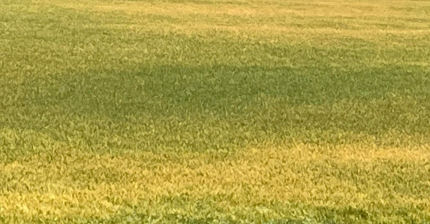As Kansas farmers pour over field trial data to select which varieties to plant this fall, new guidance is available for those considering adding or expanding fall grazing on wheat acres. K-State Research and Extension recently released the results of trials for 16 wheat varieties for performance in dual-purpose systems where wheat is grown for both forage and grain production.
Logically, the traits needed for a wheat variety to succeed in a dual-purpose system differ from programs focused solely on grain production. These performance trials evaluated commonly understood factors of fall grazing like the date of the first hollow stem as well as fall forage yield, plant height, grain yield and test weight.
To do so, K-State researchers planted three trials in the South Central Experiment Field near Hutchinson. One trial followed grain-only management practices, while the other two trials simulated dual-purpose management. These trials included an earlier planting date with a higher seeding rate and increased nitrogen applications.
The first dual-purpose trial assessed forage yield and date of the first hollow stem. Fall forage production depends on variety selection, environmental factors — temperature and precipitation — and management decisions — planting date, seeding rate and nitrogen application rate.
To measure forage yield, researchers hand-clipped and dried samples before weighing and measuring the remaining dry matter. The team found significant statistical differences in fall forage production between the tested varieties, ranging from 871 to 1,969 pounds of dry matter per acre. Eleven of the 16 varieties were considered high-yielding — 1,370 to 1,969 pounds of dry matter per acre — including KS Ahearn and KS Providence.
To balance the use of that forage potential with future grain yield potential, producers with a dual-purpose system use the date of the first hollow stem as an indicator of when to stop grazing. Grazing past that first hollow stem date can decrease yields by as much as one to five percent per day. While the appearance of the first hollow stem is driven by decreasing temperatures and day length, individual varieties can differ by up to 15 to 20 days.
Researchers measured the first hollow stem by splitting 10 primary stems from each plot one or two times per week, stopping when all measured stems had 1.5 centimeters of hollow stem below the developing wheat head. Results were reported in day-of-year format with the average occurrence of the first hollow stem on day 76 or March 17. All the studied varieties reached the first hollow stem within an 11-day window, with KS Providence being the latest variety to achieve the first hollow stem at day 83.
After producers stop grazing, their focus turns to maximizing grain production. The second dual-purpose trial explored the penalties for grazing wheat fields come harvest.
First, researchers simulated grazing by mowing plants to 1.5 inches whenever regrowth hit two inches. This happened five times before researchers stopped the simulated grazing at the average first hollow stem date. The team then measured plant height for the rest of the grazing season and harvested the grain from the trial.
For the grain-only trial, yields averaged 53.5 bushels per acre, compared to 28.1 bushels per acre in the dual-purpose trial — meaning the yield penalty from simulated grazing averaged 13.6 bushels per acre. The penalty for varieties averaged from 6.9 to 19.7 bushels per acre with the highest-yielding group including AR Iron Eagle 22AX, CP7017AX, Guardian, Golden Hawk and WB4347.
Test weights also varied between varieties, ranging from 55.1 to 62.7 pounds per bushel in the grain-only system to 49.5 to 67.1 pounds per bushel in the dual-purpose trial. Guardian ranked as the highest test weight in both systems, whereas AP Sunbird (experimental) ranked highest in the grain-only trial and WB4347 took the top spot in the dual-purpose system.
Researchers noted that weather conditions — fall moisture and a dry spring — also impacted final grain yields and test weights.
Overall, the K-State evaluation provides valuable insights for producers looking to balance needs for additional forage with the goal of a successful summer harvest. The publication is part of the Wheat Rx series, a partnership between Kansas Wheat and K-State Research and Extension to disseminate the latest research recommendations for high-yielding and high-quality wheat to Kansas wheat farmers.
_ _ _
Find the full publication and other resources at kswheat.com/wheatrx.



